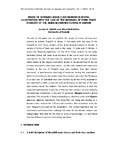| dc.contributor.author | Simiyu, Jacinta N; Buregeya, Alfred | |
| dc.date.accessioned | 2013-06-28T06:47:45Z | |
| dc.date.available | 2013-06-28T06:47:45Z | |
| dc.date.issued | 2010 | |
| dc.identifier.citation | Simiyu, J, Buregeya A. 2010. "Misuse of Kiswahili noun class markers in Kenya", The University of Nairobi Journal of Language and Linguistics, Vol. 1, pp. 48-70.. The University of Nairobi Journal of Language and Linguistics. 1(1):48-70.: John Benjamins Publishing Company | en |
| dc.identifier.uri | http://profiles.uonbi.ac.ke/aburegeya/publications/misuse-kiswahili-noun-class-markers-kenya-university-nairobi-journal-langua-0 | |
| dc.identifier.uri | http://erepository.uonbi.ac.ke:8080/xmlui/handle/123456789/41438 | |
| dc.identifier.uri | https://linguistics.uonbi.ac.ke/basic-page/university-nairobi-journal-linguistics-and-languages | |
| dc.description.abstract | The aim of this paper was to establish the extent of misuse of noun class markers in written Kiswahili in Kenya. It illustrates with the case of the Kiswahili of Form Three students of the Akiba Secondary School in Nairobi. A sample of thirty of them was used in the study: 15 male and 15 female. It tested the following hypotheses: (i) The Form Three students of the Akiba Secondary School will make more mistakes in the use of noun class markers reserved for the the I-ZI noun class—as would be used for the pair of nouns sahani (plate) in the singular and sahani (plates) in the plural—than in the use of those reserved for other noun classes. (ii) The male students will make more mistakes in the use of Kiswahili noun class markers than their female classmates. A questionnaire consisting of sentences testing the respondents’ ability to correctly use the various noun class markers was used. The frequency of correct uses of individual noun class markers by all the thirty respondents was reported in a table, as was the total performance on each one of the noun class markers by all the students. The results show that contrary to what the study had hypothesized, it was the A–WA noun class markers (as illustrated by the bold-type morphemes in the pair of sentences Kipepeo anaruka akitua mgombani (The butterfly is flying and landing on a banana trunk) and Vipepeo wanaruka wakitua migombani (The butterflies are flying and landing on a banana trunk), and not the I-ZI noun class markers, that turned out to be the most frequently misused by the respondents. The second hypothesis was not statistically confirmed either: although the mean for the female students was indeed higher than that for the male in terms of percentages, a t-test found that the difference was not statistically significant | |
| dc.language.iso | en | en |
| dc.subject | University of Nairobi Journal of Linguistics and Languages | |
| dc.title | Misuse of Kiswahili noun class markers in Kenya: illustration with the case of the Kiswahili of form-three students of the Akiba secondary school in Nairobi | en |
| dc.type | Article | en |
| local.publisher | Linguistics and Languages, University of Nairobi | en |

